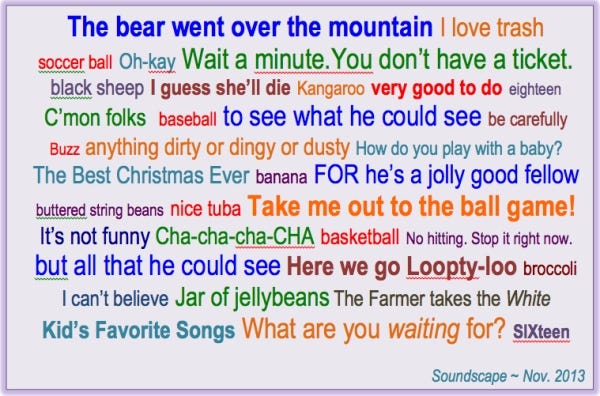We had a houseguest once who said that my house was too quiet.
I can’t imagine anyone would ever say that now.
Sure, background noise from the radio or TV is subdued in deference to my son’s aversion to loud sounds, and we generally talk at a lower volume.
Well, at least my husband and I do.
My son, on the other hand, is the loudest “non-verbal” kid you might ever meet.
Despite his limited verbal interactions (the number of the times in a day that he talks with intent would barely fill one piece of paper), my kid uses his voice all the time. ALL the time. His favorite self-stimulatory behavior (or “stim”) is repeating the words he’s memorized from movies, songs, books and his day-to-day life. During his verbal stimming, he is not intending to communicate to anyone (I don’t think) – but he is clearly expressing his joy at the noise he is able to create.
He plays with sound, rolling syllables around in different combinations and enjoying the patterns coming out of his mouth. The soundscape he engineers changes over time, and I wish I’d been better about writing down the old phrases and songs he used to have in his circuit.
Some of those classics serve as inside jokes for me and my husband, and I’ll have to look back and record them at some point. For now, I am going to make note of his soundscape every few months to help me remember.
We can’t always catch what my son is saying - sometimes the sounds he makes aren’t words at all, but perhaps an attempt to play with rhythm or re-imagine the language he hears.
When we recognize the words, we typically find that they come from songs that he heard a long time ago. You know how a song gets stuck in your head? My kid’s head is full of songs - when he learns one, I don’t think it ever leaves.
Lately, his favorites have merged into a complex medley, with a few words from other books or movie scenes thrown in. These are usually sung or spoken at full volume (sometimes he whispers, but I don't think it’s as much fun), and the different combinations he comes up with can really set him to laughing. This medley often includes a “beat box” flavor, rhythmic grunts and clicks and chest thumping that infuse old preschool rhymes with a little “boom-chicka.”
These phrases and song snippets seem like “nonsense” to anyone else. Random syllables, sped up and strung together, or pronounced singularly with exaggerated emphasis, elongated and stretched into wholly new sounds.
Granted, this stim is challenging for those of us on the outside – when he’s loudly declaring “TAKE ME OUT TO THE BALLGAME” at three in the morning, or cha-cha-cha-ing when my husband and I are trying to hear each other (or the TV), or when I really need this “non-verbal” kid to focus on the task at hand.
But I still cherish these words. Although his verbalizations aren’t intended to communicate with me, they can still help us connect. I can participate in his soundscape by writing the words on his white board as he says them. He’ll let me jot down a few, enjoying the concrete formation of those sounds in letters, repeating the words and adjusting his pronunciation – he can recognize that sometimes the words look different than how he’s heard them. He encourages me to change the order on the board so he can read them in different combinations.
The other night, I showed him how to record a Voice Memo on my phone, and we recorded several snippets together. We spent the evening replaying those snippets and adding others, his head bopping to the beat, mouthing the familiar lines, and laughing every time he heard his own voice coming out of my phone.
When my husband or I join his soundscape and repeat what he says, he lights up.
When we finish a “nonsense” phrase that we’ve heard so often, even though we don’t always understand what it means, he gives us a knowing grin.
When we throw a familiar word or song lyric out to him at some random time, he volleys back with another, and we are having a conversation.
I have no idea what we’re talking about, but these are still some of the best conversations I’ve ever had.
***




